class: inverse, middle background-image: url(https://images.unsplash.com/photo-1592173376801-185310a68dea?ixlib=rb-1.2.1&ixid=MnwxMjA3fDB8MHxwaG90by1wYWdlfHx8fGVufDB8fHx8&auto=format&fit=crop&w=1286&q=80) background-size: cover # Easy geom_*() recipes, 2024 ###Gina Reynolds and Morgan Brown <br> <br> <br> <style type="text/css"> .remark-code{line-height: 1.5; font-size: 90%} @media print { .has-continuation { display: block; } } code.r.hljs.remark-code{ position: relative; overflow-x: hidden; } code.r.hljs.remark-code:hover{ overflow-x:visible; width: 500px; border-style: solid; } </style> --- ### Using ggplot2 has been described as writing 'graphical poems'. -- <!-- and a system that lets us 'speak our plot into existence'. --> ### But we may feel at a loss for words when functions we'd like to have don't exist. The ggplot2 extension system allows us to build new 'vocabulary' for fluent expression. -- ### An exciting extension mechanism that allows more plotting fluidity is to create new, custom 'Stats' and combine them with existing 'Geoms' (GeomPoint, GeomText, GeomSegment, etc)into new geom\_\* or stat\_\* functions. --- ### By the way, you might only be familiar with the user-facing geom_point(), geom_text(), geom_segment() layer functions that use the more primitive GeomPoint, GeomText, and GeomSegment under the hood, and that's okay. You might also have a feel for existing stats like StatCount and StatBin, specify computation in user-facing functions like geom_bar() and geom_histogram(). --- ### To get your feet wet in this world and give you a taste of patterns for new-Stat-plus-existing-Geom extension, we provide three *introductory* recipes (A, B, and C) for geom\_\* functions that make use of newly defined 'Stats' and *existing* 'Geoms' along with three practice exercises: *Easy geom\_() recipes* --- ### With your new geom\_\*() function, calculation is done under the hood by the ggplot2 system; with these geom\_\*() functions, you can write graphical poems with concise new language you've tailored for goals! --- ### This tutorial is intended for individuals who already have a working knowledge of the grammar of ggplot2, but may like to build a richer vocabulary for themselves. -- ### Grab an .Rmd worksheet version [here](https://raw.githubusercontent.com/EvaMaeRey/mytidytuesday/master/2022-01-03-easy-geom-recipes/easy_geom_recipes_2024.Rmd). ### or you can browse the rendered version of that [here](https://evamaerey.github.io/mytidytuesday/2022-01-03-easy-geom-recipes/easy_geom_recipes_2024.html). --- ## *Recipes Form Preview:* -- ## **Step 0. Get the job done with 'base' ggplot2.** <!-- ## *It's a good idea to clarify what needs to happen without getting into the extension architecture.* --> -- ## **Step 1. Use base build experience to help define compute and test.** <!-- ## *Define compute that will transform your input data before rendering it. Try it out.* --> -- ## **Step 2. Use compute definition to define a new Stat and test.** <!-- ## *Stats, which are ggproto objects, allow your to get compute done within a ggplot2 build! You'll use the computation function from Step 1 to build your Stat. Then, use the stat with the generic ggplot `layer()` function to test it out. `layer()` lets you combine stats and geoms for very flexible expression and used to create the user-facing layer functions that you're familiar with geom_point, geom_histogram, etc.* --> -- ## **Step 3. Use your new Stat to define a user-facing geom\_\*() function and test.** <!-- ## *You're ready to write your target function! We'll define a user-facing function using `layer()` function and the newly defined stat from Step 2. Test/Enjoy!* --> --- class: inverse, middle, center # Recipe A. -- ## `geom_medians()` --- class: inverse, middle, center ## Step 0: use base ggplot2 to get the job done -- ### *Clarify what needs to happen without getting into the extension architecture.* --- count: false .panel1-penguins-user[ ```r *library(tidyverse) *library(palmerpenguins) *penguins <- remove_missing(penguins) *penguins ``` ] .panel2-penguins-user[ ``` # A tibble: 333 × 8 species island bill_length_mm bill_depth_mm flipper_length_mm body_mass_g sex year <fct> <fct> <dbl> <dbl> <int> <int> <fct> <int> 1 Adelie Torgersen 39.1 18.7 181 3750 male 2007 2 Adelie Torgersen 39.5 17.4 186 3800 female 2007 3 Adelie Torgersen 40.3 18 195 3250 female 2007 4 Adelie Torgersen 36.7 19.3 193 3450 female 2007 5 Adelie Torgersen 39.3 20.6 190 3650 male 2007 6 Adelie Torgersen 38.9 17.8 181 3625 female 2007 7 Adelie Torgersen 39.2 19.6 195 4675 male 2007 8 Adelie Torgersen 41.1 17.6 182 3200 female 2007 9 Adelie Torgersen 38.6 21.2 191 3800 male 2007 10 Adelie Torgersen 34.6 21.1 198 4400 male 2007 11 Adelie Torgersen 36.6 17.8 185 3700 female 2007 12 Adelie Torgersen 38.7 19 195 3450 female 2007 13 Adelie Torgersen 42.5 20.7 197 4500 male 2007 14 Adelie Torgersen 34.4 18.4 184 3325 female 2007 15 Adelie Torgersen 46 21.5 194 4200 male 2007 16 Adelie Biscoe 37.8 18.3 174 3400 female 2007 17 Adelie Biscoe 37.7 18.7 180 3600 male 2007 18 Adelie Biscoe 35.9 19.2 189 3800 female 2007 19 Adelie Biscoe 38.2 18.1 185 3950 male 2007 20 Adelie Biscoe 38.8 17.2 180 3800 male 2007 21 Adelie Biscoe 35.3 18.9 187 3800 female 2007 22 Adelie Biscoe 40.6 18.6 183 3550 male 2007 23 Adelie Biscoe 40.5 17.9 187 3200 female 2007 24 Adelie Biscoe 37.9 18.6 172 3150 female 2007 25 Adelie Biscoe 40.5 18.9 180 3950 male 2007 26 Adelie Dream 39.5 16.7 178 3250 female 2007 27 Adelie Dream 37.2 18.1 178 3900 male 2007 28 Adelie Dream 39.5 17.8 188 3300 female 2007 29 Adelie Dream 40.9 18.9 184 3900 male 2007 30 Adelie Dream 36.4 17 195 3325 female 2007 31 Adelie Dream 39.2 21.1 196 4150 male 2007 32 Adelie Dream 38.8 20 190 3950 male 2007 33 Adelie Dream 42.2 18.5 180 3550 female 2007 34 Adelie Dream 37.6 19.3 181 3300 female 2007 35 Adelie Dream 39.8 19.1 184 4650 male 2007 36 Adelie Dream 36.5 18 182 3150 female 2007 37 Adelie Dream 40.8 18.4 195 3900 male 2007 38 Adelie Dream 36 18.5 186 3100 female 2007 39 Adelie Dream 44.1 19.7 196 4400 male 2007 40 Adelie Dream 37 16.9 185 3000 female 2007 41 Adelie Dream 39.6 18.8 190 4600 male 2007 42 Adelie Dream 41.1 19 182 3425 male 2007 43 Adelie Dream 36 17.9 190 3450 female 2007 44 Adelie Dream 42.3 21.2 191 4150 male 2007 45 Adelie Biscoe 39.6 17.7 186 3500 female 2008 46 Adelie Biscoe 40.1 18.9 188 4300 male 2008 47 Adelie Biscoe 35 17.9 190 3450 female 2008 48 Adelie Biscoe 42 19.5 200 4050 male 2008 49 Adelie Biscoe 34.5 18.1 187 2900 female 2008 50 Adelie Biscoe 41.4 18.6 191 3700 male 2008 51 Adelie Biscoe 39 17.5 186 3550 female 2008 52 Adelie Biscoe 40.6 18.8 193 3800 male 2008 53 Adelie Biscoe 36.5 16.6 181 2850 female 2008 54 Adelie Biscoe 37.6 19.1 194 3750 male 2008 55 Adelie Biscoe 35.7 16.9 185 3150 female 2008 # ℹ 278 more rows ``` ] --- count: false .panel1-penguins-user[ ```r library(tidyverse) library(palmerpenguins) penguins <- remove_missing(penguins) penguins %>% * summarize(bill_length_mm_median = * median(bill_length_mm), * bill_depth_mm_median = * median(bill_depth_mm)) ``` ] .panel2-penguins-user[ ``` # A tibble: 1 × 2 bill_length_mm_median bill_depth_mm_median <dbl> <dbl> 1 44.5 17.3 ``` ] --- count: false .panel1-penguins-user[ ```r library(tidyverse) library(palmerpenguins) penguins <- remove_missing(penguins) penguins %>% summarize(bill_length_mm_median = median(bill_length_mm), bill_depth_mm_median = median(bill_depth_mm)) -> *penguins_medians ``` ] .panel2-penguins-user[ ] --- count: false .panel1-penguins-user[ ```r library(tidyverse) library(palmerpenguins) penguins <- remove_missing(penguins) penguins %>% summarize(bill_length_mm_median = median(bill_length_mm), bill_depth_mm_median = median(bill_depth_mm)) -> penguins_medians *penguins %>% * ggplot() + * aes(x = bill_depth_mm) + * aes(y = bill_length_mm) + * geom_point() ``` ] .panel2-penguins-user[ 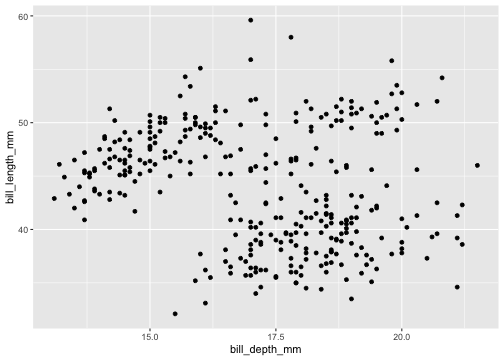<!-- --> ] --- count: false .panel1-penguins-user[ ```r library(tidyverse) library(palmerpenguins) penguins <- remove_missing(penguins) penguins %>% summarize(bill_length_mm_median = median(bill_length_mm), bill_depth_mm_median = median(bill_depth_mm)) -> penguins_medians penguins %>% ggplot() + aes(x = bill_depth_mm) + aes(y = bill_length_mm) + geom_point() + * geom_point(data = penguins_medians, * color = "red", * size = 4, * aes(x = bill_depth_mm_median, * y = bill_length_mm_median)) ``` ] .panel2-penguins-user[ <!-- --> ] --- count: false .panel1-penguins-user[ ```r library(tidyverse) library(palmerpenguins) penguins <- remove_missing(penguins) penguins %>% summarize(bill_length_mm_median = median(bill_length_mm), bill_depth_mm_median = median(bill_depth_mm)) -> penguins_medians penguins %>% ggplot() + aes(x = bill_depth_mm) + aes(y = bill_length_mm) + geom_point() + geom_point(data = penguins_medians, color = "red", size = 4, aes(x = bill_depth_mm_median, y = bill_length_mm_median)) # Have a quick look at the layer_data medians layer *layer_data(plot = last_plot(), i = 2) ``` ] .panel2-penguins-user[ 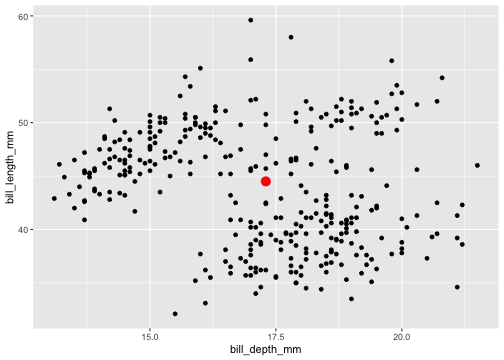<!-- --> ``` x y PANEL group shape colour size fill alpha stroke 1 17.3 44.5 1 -1 19 red 4 NA NA 0.5 ``` ] <style> .panel1-penguins-user { color: black; width: 38.6060606060606%; hight: 32%; float: left; padding-left: 1%; font-size: 80% } .panel2-penguins-user { color: black; width: 59.3939393939394%; hight: 32%; float: left; padding-left: 1%; font-size: 80% } .panel3-penguins-user { color: black; width: NA%; hight: 33%; float: left; padding-left: 1%; font-size: 80% } </style> --- class: inverse, middle, center ## Step 1: Define Compute and test. -- ### *Define the compute that will transform your input data before rendering it. Try it out.* --- count: false .panel1-compute_group_medians-auto[ ```r *compute_group_medians <- function(data, * scales){ * data %>% * summarize(x = median(x), * y = median(y)) *} ``` ] .panel2-compute_group_medians-auto[ ] --- count: false .panel1-compute_group_medians-auto[ ```r compute_group_medians <- function(data, scales){ data %>% summarize(x = median(x), y = median(y)) } # And use computation function to test it *penguins ``` ] .panel2-compute_group_medians-auto[ ``` # A tibble: 333 × 8 species island bill_length_mm bill_depth_mm flipper_length_mm body_mass_g sex year <fct> <fct> <dbl> <dbl> <int> <int> <fct> <int> 1 Adelie Torgersen 39.1 18.7 181 3750 male 2007 2 Adelie Torgersen 39.5 17.4 186 3800 female 2007 3 Adelie Torgersen 40.3 18 195 3250 female 2007 4 Adelie Torgersen 36.7 19.3 193 3450 female 2007 5 Adelie Torgersen 39.3 20.6 190 3650 male 2007 6 Adelie Torgersen 38.9 17.8 181 3625 female 2007 7 Adelie Torgersen 39.2 19.6 195 4675 male 2007 8 Adelie Torgersen 41.1 17.6 182 3200 female 2007 9 Adelie Torgersen 38.6 21.2 191 3800 male 2007 10 Adelie Torgersen 34.6 21.1 198 4400 male 2007 11 Adelie Torgersen 36.6 17.8 185 3700 female 2007 12 Adelie Torgersen 38.7 19 195 3450 female 2007 13 Adelie Torgersen 42.5 20.7 197 4500 male 2007 14 Adelie Torgersen 34.4 18.4 184 3325 female 2007 15 Adelie Torgersen 46 21.5 194 4200 male 2007 16 Adelie Biscoe 37.8 18.3 174 3400 female 2007 17 Adelie Biscoe 37.7 18.7 180 3600 male 2007 18 Adelie Biscoe 35.9 19.2 189 3800 female 2007 19 Adelie Biscoe 38.2 18.1 185 3950 male 2007 20 Adelie Biscoe 38.8 17.2 180 3800 male 2007 21 Adelie Biscoe 35.3 18.9 187 3800 female 2007 22 Adelie Biscoe 40.6 18.6 183 3550 male 2007 23 Adelie Biscoe 40.5 17.9 187 3200 female 2007 24 Adelie Biscoe 37.9 18.6 172 3150 female 2007 25 Adelie Biscoe 40.5 18.9 180 3950 male 2007 26 Adelie Dream 39.5 16.7 178 3250 female 2007 27 Adelie Dream 37.2 18.1 178 3900 male 2007 28 Adelie Dream 39.5 17.8 188 3300 female 2007 29 Adelie Dream 40.9 18.9 184 3900 male 2007 30 Adelie Dream 36.4 17 195 3325 female 2007 31 Adelie Dream 39.2 21.1 196 4150 male 2007 32 Adelie Dream 38.8 20 190 3950 male 2007 33 Adelie Dream 42.2 18.5 180 3550 female 2007 34 Adelie Dream 37.6 19.3 181 3300 female 2007 35 Adelie Dream 39.8 19.1 184 4650 male 2007 36 Adelie Dream 36.5 18 182 3150 female 2007 37 Adelie Dream 40.8 18.4 195 3900 male 2007 38 Adelie Dream 36 18.5 186 3100 female 2007 39 Adelie Dream 44.1 19.7 196 4400 male 2007 40 Adelie Dream 37 16.9 185 3000 female 2007 41 Adelie Dream 39.6 18.8 190 4600 male 2007 42 Adelie Dream 41.1 19 182 3425 male 2007 43 Adelie Dream 36 17.9 190 3450 female 2007 44 Adelie Dream 42.3 21.2 191 4150 male 2007 45 Adelie Biscoe 39.6 17.7 186 3500 female 2008 46 Adelie Biscoe 40.1 18.9 188 4300 male 2008 47 Adelie Biscoe 35 17.9 190 3450 female 2008 48 Adelie Biscoe 42 19.5 200 4050 male 2008 49 Adelie Biscoe 34.5 18.1 187 2900 female 2008 50 Adelie Biscoe 41.4 18.6 191 3700 male 2008 51 Adelie Biscoe 39 17.5 186 3550 female 2008 52 Adelie Biscoe 40.6 18.8 193 3800 male 2008 53 Adelie Biscoe 36.5 16.6 181 2850 female 2008 54 Adelie Biscoe 37.6 19.1 194 3750 male 2008 55 Adelie Biscoe 35.7 16.9 185 3150 female 2008 # ℹ 278 more rows ``` ] --- count: false .panel1-compute_group_medians-auto[ ```r compute_group_medians <- function(data, scales){ data %>% summarize(x = median(x), y = median(y)) } # And use computation function to test it penguins %>% # function requires dataframe # with columns named x and y * select(x = bill_depth_mm, * y = bill_length_mm) ``` ] .panel2-compute_group_medians-auto[ ``` # A tibble: 333 × 2 x y <dbl> <dbl> 1 18.7 39.1 2 17.4 39.5 3 18 40.3 4 19.3 36.7 5 20.6 39.3 6 17.8 38.9 7 19.6 39.2 8 17.6 41.1 9 21.2 38.6 10 21.1 34.6 11 17.8 36.6 12 19 38.7 13 20.7 42.5 14 18.4 34.4 15 21.5 46 16 18.3 37.8 17 18.7 37.7 18 19.2 35.9 19 18.1 38.2 20 17.2 38.8 21 18.9 35.3 22 18.6 40.6 23 17.9 40.5 24 18.6 37.9 25 18.9 40.5 26 16.7 39.5 27 18.1 37.2 28 17.8 39.5 29 18.9 40.9 30 17 36.4 31 21.1 39.2 32 20 38.8 33 18.5 42.2 34 19.3 37.6 35 19.1 39.8 36 18 36.5 37 18.4 40.8 38 18.5 36 39 19.7 44.1 40 16.9 37 41 18.8 39.6 42 19 41.1 43 17.9 36 44 21.2 42.3 45 17.7 39.6 46 18.9 40.1 47 17.9 35 48 19.5 42 49 18.1 34.5 50 18.6 41.4 51 17.5 39 52 18.8 40.6 53 16.6 36.5 54 19.1 37.6 55 16.9 35.7 # ℹ 278 more rows ``` ] --- count: false .panel1-compute_group_medians-auto[ ```r compute_group_medians <- function(data, scales){ data %>% summarize(x = median(x), y = median(y)) } # And use computation function to test it penguins %>% # function requires dataframe # with columns named x and y select(x = bill_depth_mm, y = bill_length_mm) %>% * compute_group_medians() ``` ] .panel2-compute_group_medians-auto[ ``` # A tibble: 1 × 2 x y <dbl> <dbl> 1 17.3 44.5 ``` ] <style> .panel1-compute_group_medians-auto { color: black; width: 38.6060606060606%; hight: 32%; float: left; padding-left: 1%; font-size: 80% } .panel2-compute_group_medians-auto { color: black; width: 59.3939393939394%; hight: 32%; float: left; padding-left: 1%; font-size: 80% } .panel3-compute_group_medians-auto { color: black; width: NA%; hight: 33%; float: left; padding-left: 1%; font-size: 80% } </style> --- class: inverse, middle, center ## Step 2: define a new Stat -- ### *Stats, which are ggproto objects, allow your to get compute done within a ggplot2 build. You'll use the computation function from Step 1 to define your Stat.* -- ### *To test out the Stat behavior you can use the generic `ggplot2::layer()` function. `layer()` lets you combine Stats and Geoms for very flexible expression. It is used to define the user-facing layer functions that you're familiar with like geom_point, geom_histogram, etc.* --- count: false .panel1-StatMedians-user[ ```r # define new Stat *StatMedians <- ggplot2::ggproto( # declare new Stat * `_class` = "StatMedians", # inherit behavior of generic stat * `_inherit` = ggplot2::Stat, # state required variable mappings * required_aes = c("x", "y"), # declare computation definition for stat * compute_group = compute_group_medians * ) ``` ] .panel2-StatMedians-user[ ] --- count: false .panel1-StatMedians-user[ ```r # define new Stat StatMedians <- ggplot2::ggproto( # declare new Stat `_class` = "StatMedians", # inherit behavior of generic stat `_inherit` = ggplot2::Stat, # state required variable mappings required_aes = c("x", "y"), # declare computation definition for stat compute_group = compute_group_medians ) *# test new stat w ggplot::layer() function # test new stat w ggplot::layer() function *penguins %>% * ggplot() + * aes(x = bill_depth_mm) + * aes(y = bill_length_mm) + * geom_point() ``` ] .panel2-StatMedians-user[ 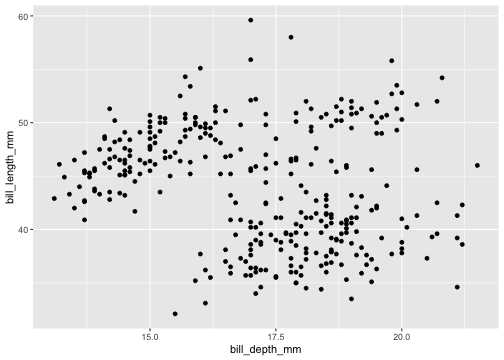<!-- --> ] --- count: false .panel1-StatMedians-user[ ```r # define new Stat StatMedians <- ggplot2::ggproto( # declare new Stat `_class` = "StatMedians", # inherit behavior of generic stat `_inherit` = ggplot2::Stat, # state required variable mappings required_aes = c("x", "y"), # declare computation definition for stat compute_group = compute_group_medians ) # test new stat w ggplot::layer() function # test new stat w ggplot::layer() function penguins %>% ggplot() + aes(x = bill_depth_mm) + aes(y = bill_length_mm) + geom_point() + * layer(geom = GeomPoint, * stat = StatMedians, * position = "identity", * params = list(size = 8)) ``` ] .panel2-StatMedians-user[ 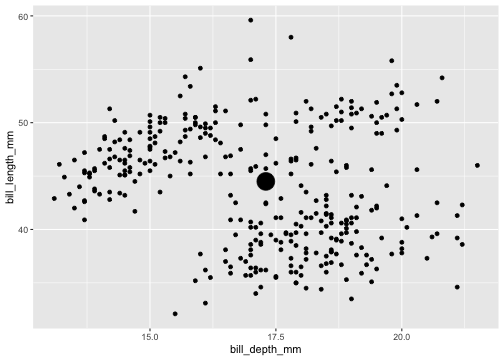<!-- --> ] <style> .panel1-StatMedians-user { color: black; width: 38.6060606060606%; hight: 32%; float: left; padding-left: 1%; font-size: 80% } .panel2-StatMedians-user { color: black; width: 59.3939393939394%; hight: 32%; float: left; padding-left: 1%; font-size: 80% } .panel3-StatMedians-user { color: black; width: NA%; hight: 33%; float: left; padding-left: 1%; font-size: 80% } </style> --- class: inverse, middle, center ## Step 3: define user-facing geom\_\* function -- ### *For ease of use, we'll wrap the layer function into a familiar `geom` function.* ### *We manage arguments like mapping, data, position, na.rm, show.legend, inherit.aes, etc, so that the new, user-facing function will behave similarly to other user-facing geom functions that you are familiar with.* --- count: false .panel1-geom_medians-user[ ```r *geom_medians <- function( * mapping = NULL, data = NULL, * position = "identity", na.rm = FALSE, * show.legend = NA, inherit.aes = TRUE, * ... ){ *ggplot2::layer( * stat = StatMedians, * geom = ggplot2::GeomPoint, * data = data, * mapping = mapping, * position = position, * show.legend = show.legend, * inherit.aes = inherit.aes, * params = list(na.rm = na.rm, ...) * ) *} ``` ] .panel2-geom_medians-user[ ] --- count: false .panel1-geom_medians-user[ ```r geom_medians <- function( mapping = NULL, data = NULL, position = "identity", na.rm = FALSE, show.legend = NA, inherit.aes = TRUE, ... ){ ggplot2::layer( stat = StatMedians, geom = ggplot2::GeomPoint, data = data, mapping = mapping, position = position, show.legend = show.legend, inherit.aes = inherit.aes, params = list(na.rm = na.rm, ...) ) } *penguins %>% * ggplot() + * aes(x = bill_depth_mm, * y = bill_length_mm) + * geom_point() ``` ] .panel2-geom_medians-user[ <!-- --> ] --- count: false .panel1-geom_medians-user[ ```r geom_medians <- function( mapping = NULL, data = NULL, position = "identity", na.rm = FALSE, show.legend = NA, inherit.aes = TRUE, ... ){ ggplot2::layer( stat = StatMedians, geom = ggplot2::GeomPoint, data = data, mapping = mapping, position = position, show.legend = show.legend, inherit.aes = inherit.aes, params = list(na.rm = na.rm, ...) ) } penguins %>% ggplot() + aes(x = bill_depth_mm, y = bill_length_mm) + geom_point() + * geom_medians(size = 8) ``` ] .panel2-geom_medians-user[ 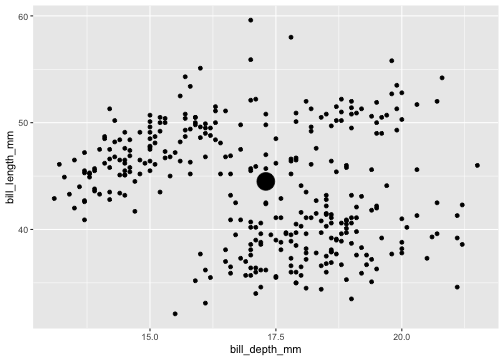<!-- --> ] <style> .panel1-geom_medians-user { color: black; width: 38.6060606060606%; hight: 32%; float: left; padding-left: 1%; font-size: 80% } .panel2-geom_medians-user { color: black; width: 59.3939393939394%; hight: 32%; float: left; padding-left: 1%; font-size: 80% } .panel3-geom_medians-user { color: black; width: NA%; hight: 33%; float: left; padding-left: 1%; font-size: 80% } </style> --- class: inverse, middle, center ### And check out group-wise behavior! --- count: false .panel1-conditional_penguins-auto[ ```r *last_plot() ``` ] .panel2-conditional_penguins-auto[ 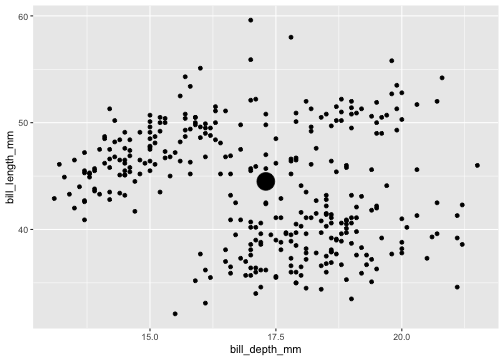<!-- --> ] --- count: false .panel1-conditional_penguins-auto[ ```r last_plot() + * aes(color = species) ``` ] .panel2-conditional_penguins-auto[ 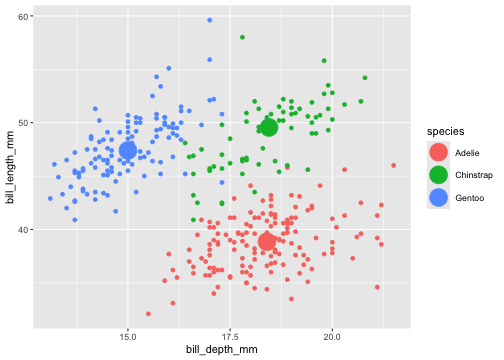<!-- --> ] <style> .panel1-conditional_penguins-auto { color: black; width: 38.6060606060606%; hight: 32%; float: left; padding-left: 1%; font-size: 80% } .panel2-conditional_penguins-auto { color: black; width: 59.3939393939394%; hight: 32%; float: left; padding-left: 1%; font-size: 80% } .panel3-conditional_penguins-auto { color: black; width: NA%; hight: 33%; float: left; padding-left: 1%; font-size: 80% } </style> --- class: inverse, middle, center background-image: url(https://images.unsplash.com/photo-1628559225804-71f6e4643f44?ixlib=rb-1.2.1&ixid=MnwxMjA3fDB8MHxwaG90by1wYWdlfHx8fGVufDB8fHx8&auto=format&fit=crop&w=837&q=80) background-size: cover --- class: inverse, middle, center ## Now you ... -- ### Create the function `geom_means()` --- class: inverse, middle, center # Recipe B. -- ## `geom_label_id()` --- class: inverse, center, middle ## Step 0: use base ggplot2 to get the job done --- count: false .panel1-cars-auto[ ```r *cars ``` ] .panel2-cars-auto[ ``` speed dist 1 4 2 2 4 10 3 7 4 4 7 22 5 8 16 6 9 10 7 10 18 8 10 26 9 10 34 10 11 17 11 11 28 12 12 14 13 12 20 14 12 24 15 12 28 16 13 26 17 13 34 18 13 34 19 13 46 20 14 26 21 14 36 22 14 60 23 14 80 24 15 20 25 15 26 26 15 54 27 16 32 28 16 40 29 17 32 30 17 40 31 17 50 32 18 42 33 18 56 34 18 76 35 18 84 36 19 36 37 19 46 38 19 68 39 20 32 40 20 48 41 20 52 42 20 56 43 20 64 44 22 66 45 23 54 46 24 70 47 24 92 48 24 93 49 24 120 50 25 85 ``` ] --- count: false .panel1-cars-auto[ ```r cars %>% * mutate(id_number = 1:n()) ``` ] .panel2-cars-auto[ ``` speed dist id_number 1 4 2 1 2 4 10 2 3 7 4 3 4 7 22 4 5 8 16 5 6 9 10 6 7 10 18 7 8 10 26 8 9 10 34 9 10 11 17 10 11 11 28 11 12 12 14 12 13 12 20 13 14 12 24 14 15 12 28 15 16 13 26 16 17 13 34 17 18 13 34 18 19 13 46 19 20 14 26 20 21 14 36 21 22 14 60 22 23 14 80 23 24 15 20 24 25 15 26 25 26 15 54 26 27 16 32 27 28 16 40 28 29 17 32 29 30 17 40 30 31 17 50 31 32 18 42 32 33 18 56 33 34 18 76 34 35 18 84 35 36 19 36 36 37 19 46 37 38 19 68 38 39 20 32 39 40 20 48 40 41 20 52 41 42 20 56 42 43 20 64 43 44 22 66 44 45 23 54 45 46 24 70 46 47 24 92 47 48 24 93 48 49 24 120 49 50 25 85 50 ``` ] --- count: false .panel1-cars-auto[ ```r cars %>% mutate(id_number = 1:n()) %>% * ggplot() ``` ] .panel2-cars-auto[ <!-- --> ] --- count: false .panel1-cars-auto[ ```r cars %>% mutate(id_number = 1:n()) %>% ggplot() + * aes(x = speed, y = dist) ``` ] .panel2-cars-auto[ 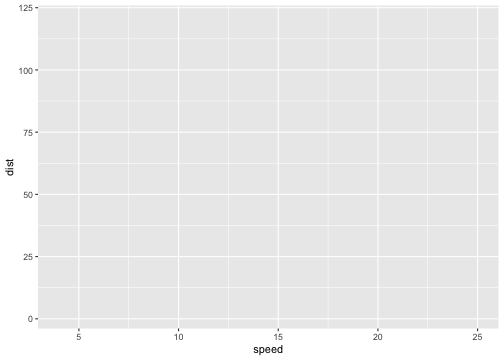<!-- --> ] --- count: false .panel1-cars-auto[ ```r cars %>% mutate(id_number = 1:n()) %>% ggplot() + aes(x = speed, y = dist) + * geom_point() ``` ] .panel2-cars-auto[ 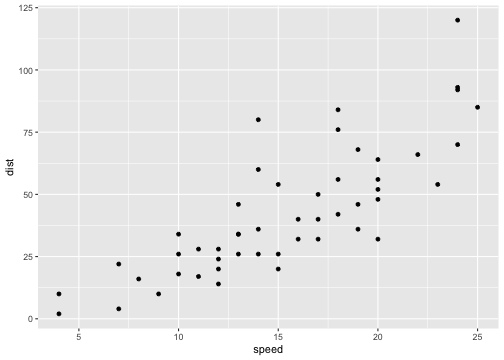<!-- --> ] --- count: false .panel1-cars-auto[ ```r cars %>% mutate(id_number = 1:n()) %>% ggplot() + aes(x = speed, y = dist) + geom_point() + * geom_label(aes(label = id_number), * hjust = 1.2) ``` ] .panel2-cars-auto[ 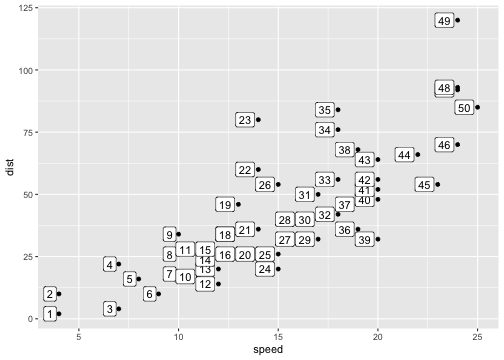<!-- --> ] <style> .panel1-cars-auto { color: black; width: 38.6060606060606%; hight: 32%; float: left; padding-left: 1%; font-size: 80% } .panel2-cars-auto { color: black; width: 59.3939393939394%; hight: 32%; float: left; padding-left: 1%; font-size: 80% } .panel3-cars-auto { color: black; width: NA%; hight: 33%; float: left; padding-left: 1%; font-size: 80% } </style> --- class: inverse, middle, center ## Step 1: define computation --- count: false .panel1-compute_group_row_number-auto[ ```r # you won't use the scales argument, but ggplot will later *compute_group_row_number <- function(data, * scales){ * data %>% # add an additional column called label # the geom we inherit from requires the label aesthetic * mutate(label = 1:n()) *} ``` ] .panel2-compute_group_row_number-auto[ ] --- count: false .panel1-compute_group_row_number-auto[ ```r # you won't use the scales argument, but ggplot will later compute_group_row_number <- function(data, scales){ data %>% # add an additional column called label # the geom we inherit from requires the label aesthetic mutate(label = 1:n()) } # step 1b test the computation function *cars ``` ] .panel2-compute_group_row_number-auto[ ``` speed dist 1 4 2 2 4 10 3 7 4 4 7 22 5 8 16 6 9 10 7 10 18 8 10 26 9 10 34 10 11 17 11 11 28 12 12 14 13 12 20 14 12 24 15 12 28 16 13 26 17 13 34 18 13 34 19 13 46 20 14 26 21 14 36 22 14 60 23 14 80 24 15 20 25 15 26 26 15 54 27 16 32 28 16 40 29 17 32 30 17 40 31 17 50 32 18 42 33 18 56 34 18 76 35 18 84 36 19 36 37 19 46 38 19 68 39 20 32 40 20 48 41 20 52 42 20 56 43 20 64 44 22 66 45 23 54 46 24 70 47 24 92 48 24 93 49 24 120 50 25 85 ``` ] --- count: false .panel1-compute_group_row_number-auto[ ```r # you won't use the scales argument, but ggplot will later compute_group_row_number <- function(data, scales){ data %>% # add an additional column called label # the geom we inherit from requires the label aesthetic mutate(label = 1:n()) } # step 1b test the computation function cars %>% # input must have required aesthetic inputs as columns * select(x = speed, * y = dist) ``` ] .panel2-compute_group_row_number-auto[ ``` x y 1 4 2 2 4 10 3 7 4 4 7 22 5 8 16 6 9 10 7 10 18 8 10 26 9 10 34 10 11 17 11 11 28 12 12 14 13 12 20 14 12 24 15 12 28 16 13 26 17 13 34 18 13 34 19 13 46 20 14 26 21 14 36 22 14 60 23 14 80 24 15 20 25 15 26 26 15 54 27 16 32 28 16 40 29 17 32 30 17 40 31 17 50 32 18 42 33 18 56 34 18 76 35 18 84 36 19 36 37 19 46 38 19 68 39 20 32 40 20 48 41 20 52 42 20 56 43 20 64 44 22 66 45 23 54 46 24 70 47 24 92 48 24 93 49 24 120 50 25 85 ``` ] --- count: false .panel1-compute_group_row_number-auto[ ```r # you won't use the scales argument, but ggplot will later compute_group_row_number <- function(data, scales){ data %>% # add an additional column called label # the geom we inherit from requires the label aesthetic mutate(label = 1:n()) } # step 1b test the computation function cars %>% # input must have required aesthetic inputs as columns select(x = speed, y = dist) %>% * compute_group_row_number() ``` ] .panel2-compute_group_row_number-auto[ ``` x y label 1 4 2 1 2 4 10 2 3 7 4 3 4 7 22 4 5 8 16 5 6 9 10 6 7 10 18 7 8 10 26 8 9 10 34 9 10 11 17 10 11 11 28 11 12 12 14 12 13 12 20 13 14 12 24 14 15 12 28 15 16 13 26 16 17 13 34 17 18 13 34 18 19 13 46 19 20 14 26 20 21 14 36 21 22 14 60 22 23 14 80 23 24 15 20 24 25 15 26 25 26 15 54 26 27 16 32 27 28 16 40 28 29 17 32 29 30 17 40 30 31 17 50 31 32 18 42 32 33 18 56 33 34 18 76 34 35 18 84 35 36 19 36 36 37 19 46 37 38 19 68 38 39 20 32 39 40 20 48 40 41 20 52 41 42 20 56 42 43 20 64 43 44 22 66 44 45 23 54 45 46 24 70 46 47 24 92 47 48 24 93 48 49 24 120 49 50 25 85 50 ``` ] <style> .panel1-compute_group_row_number-auto { color: black; width: 38.6060606060606%; hight: 32%; float: left; padding-left: 1%; font-size: 80% } .panel2-compute_group_row_number-auto { color: black; width: 59.3939393939394%; hight: 32%; float: left; padding-left: 1%; font-size: 80% } .panel3-compute_group_row_number-auto { color: black; width: NA%; hight: 33%; float: left; padding-left: 1%; font-size: 80% } </style> --- class: inverse, middle, center ## Step 2: define new Stat --- count: false .panel1-StatRownumber-auto[ ```r *StatRownumber <- ggplot2::ggproto( * `_class` = "StatRownumber", * `_inherit` = ggplot2::Stat, * required_aes = c("x", "y"), * compute_group = compute_group_row_number * ) ``` ] .panel2-StatRownumber-auto[ ] --- count: false .panel1-StatRownumber-auto[ ```r StatRownumber <- ggplot2::ggproto( `_class` = "StatRownumber", `_inherit` = ggplot2::Stat, required_aes = c("x", "y"), compute_group = compute_group_row_number ) ## Step 2.b: test *cars ``` ] .panel2-StatRownumber-auto[ ``` speed dist 1 4 2 2 4 10 3 7 4 4 7 22 5 8 16 6 9 10 7 10 18 8 10 26 9 10 34 10 11 17 11 11 28 12 12 14 13 12 20 14 12 24 15 12 28 16 13 26 17 13 34 18 13 34 19 13 46 20 14 26 21 14 36 22 14 60 23 14 80 24 15 20 25 15 26 26 15 54 27 16 32 28 16 40 29 17 32 30 17 40 31 17 50 32 18 42 33 18 56 34 18 76 35 18 84 36 19 36 37 19 46 38 19 68 39 20 32 40 20 48 41 20 52 42 20 56 43 20 64 44 22 66 45 23 54 46 24 70 47 24 92 48 24 93 49 24 120 50 25 85 ``` ] --- count: false .panel1-StatRownumber-auto[ ```r StatRownumber <- ggplot2::ggproto( `_class` = "StatRownumber", `_inherit` = ggplot2::Stat, required_aes = c("x", "y"), compute_group = compute_group_row_number ) ## Step 2.b: test cars %>% * mutate(id_number = 1:n()) ``` ] .panel2-StatRownumber-auto[ ``` speed dist id_number 1 4 2 1 2 4 10 2 3 7 4 3 4 7 22 4 5 8 16 5 6 9 10 6 7 10 18 7 8 10 26 8 9 10 34 9 10 11 17 10 11 11 28 11 12 12 14 12 13 12 20 13 14 12 24 14 15 12 28 15 16 13 26 16 17 13 34 17 18 13 34 18 19 13 46 19 20 14 26 20 21 14 36 21 22 14 60 22 23 14 80 23 24 15 20 24 25 15 26 25 26 15 54 26 27 16 32 27 28 16 40 28 29 17 32 29 30 17 40 30 31 17 50 31 32 18 42 32 33 18 56 33 34 18 76 34 35 18 84 35 36 19 36 36 37 19 46 37 38 19 68 38 39 20 32 39 40 20 48 40 41 20 52 41 42 20 56 42 43 20 64 43 44 22 66 44 45 23 54 45 46 24 70 46 47 24 92 47 48 24 93 48 49 24 120 49 50 25 85 50 ``` ] --- count: false .panel1-StatRownumber-auto[ ```r StatRownumber <- ggplot2::ggproto( `_class` = "StatRownumber", `_inherit` = ggplot2::Stat, required_aes = c("x", "y"), compute_group = compute_group_row_number ) ## Step 2.b: test cars %>% mutate(id_number = 1:n()) %>% * ggplot() ``` ] .panel2-StatRownumber-auto[ <!-- --> ] --- count: false .panel1-StatRownumber-auto[ ```r StatRownumber <- ggplot2::ggproto( `_class` = "StatRownumber", `_inherit` = ggplot2::Stat, required_aes = c("x", "y"), compute_group = compute_group_row_number ) ## Step 2.b: test cars %>% mutate(id_number = 1:n()) %>% ggplot() + * aes(x = speed, y = dist) ``` ] .panel2-StatRownumber-auto[ 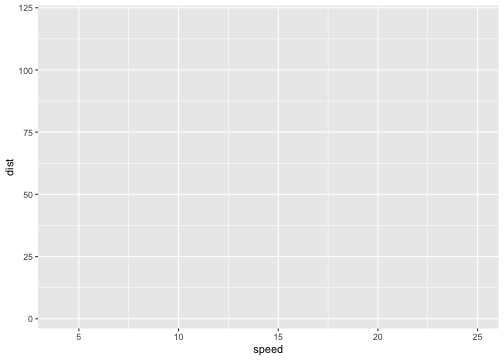<!-- --> ] --- count: false .panel1-StatRownumber-auto[ ```r StatRownumber <- ggplot2::ggproto( `_class` = "StatRownumber", `_inherit` = ggplot2::Stat, required_aes = c("x", "y"), compute_group = compute_group_row_number ) ## Step 2.b: test cars %>% mutate(id_number = 1:n()) %>% ggplot() + aes(x = speed, y = dist) + * geom_point() ``` ] .panel2-StatRownumber-auto[ 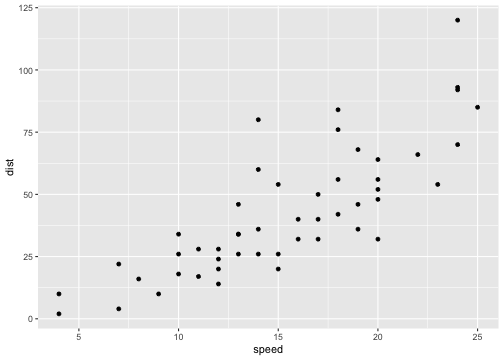<!-- --> ] --- count: false .panel1-StatRownumber-auto[ ```r StatRownumber <- ggplot2::ggproto( `_class` = "StatRownumber", `_inherit` = ggplot2::Stat, required_aes = c("x", "y"), compute_group = compute_group_row_number ) ## Step 2.b: test cars %>% mutate(id_number = 1:n()) %>% ggplot() + aes(x = speed, y = dist) + geom_point() + * layer(geom = GeomText, * stat = StatRownumber, * position = "identity") ``` ] .panel2-StatRownumber-auto[ 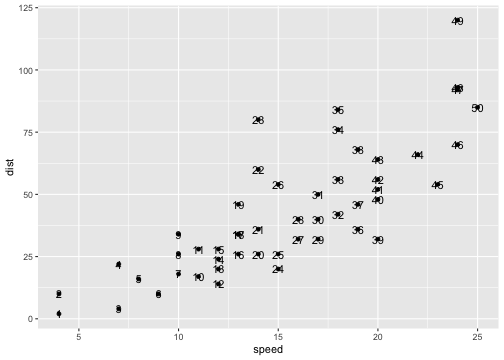<!-- --> ] <style> .panel1-StatRownumber-auto { color: black; width: 38.6060606060606%; hight: 32%; float: left; padding-left: 1%; font-size: 80% } .panel2-StatRownumber-auto { color: black; width: 59.3939393939394%; hight: 32%; float: left; padding-left: 1%; font-size: 80% } .panel3-StatRownumber-auto { color: black; width: NA%; hight: 33%; float: left; padding-left: 1%; font-size: 80% } </style> --- class: inverse, middle, center ## Step 3: define user-facing geom\_\* function --- count: false .panel1-geom_label_row_number-1[ ```r geom_label_row_number <- function( mapping = NULL, data = NULL, position = "identity", na.rm = FALSE, show.legend = NA, inherit.aes = TRUE, ...) { ggplot2::layer( stat = StatRownumber, # proto object from Step 2 geom = ggplot2::GeomLabel, # inherit other behavior data = data, mapping = mapping, position = position, show.legend = show.legend, inherit.aes = inherit.aes, params = list(na.rm = na.rm, ...) ) } ``` ] .panel2-geom_label_row_number-1[ ] <style> .panel1-geom_label_row_number-1 { color: black; width: 38.6060606060606%; hight: 32%; float: left; padding-left: 1%; font-size: 80% } .panel2-geom_label_row_number-1 { color: black; width: 59.3939393939394%; hight: 32%; float: left; padding-left: 1%; font-size: 80% } .panel3-geom_label_row_number-1 { color: black; width: NA%; hight: 33%; float: left; padding-left: 1%; font-size: 80% } </style> --- class: inverse, middle, center ## Step 3.b: Enjoy! Use your function --- count: false .panel1-enjoy_again-auto[ ```r *cars ``` ] .panel2-enjoy_again-auto[ ``` speed dist 1 4 2 2 4 10 3 7 4 4 7 22 5 8 16 6 9 10 7 10 18 8 10 26 9 10 34 10 11 17 11 11 28 12 12 14 13 12 20 14 12 24 15 12 28 16 13 26 17 13 34 18 13 34 19 13 46 20 14 26 21 14 36 22 14 60 23 14 80 24 15 20 25 15 26 26 15 54 27 16 32 28 16 40 29 17 32 30 17 40 31 17 50 32 18 42 33 18 56 34 18 76 35 18 84 36 19 36 37 19 46 38 19 68 39 20 32 40 20 48 41 20 52 42 20 56 43 20 64 44 22 66 45 23 54 46 24 70 47 24 92 48 24 93 49 24 120 50 25 85 ``` ] --- count: false .panel1-enjoy_again-auto[ ```r cars %>% * ggplot() ``` ] .panel2-enjoy_again-auto[ <!-- --> ] --- count: false .panel1-enjoy_again-auto[ ```r cars %>% ggplot() + * aes(x = speed, y = dist) ``` ] .panel2-enjoy_again-auto[ 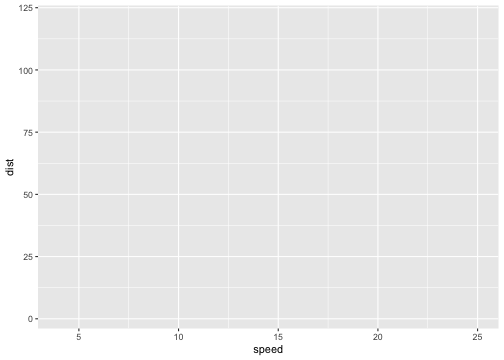<!-- --> ] --- count: false .panel1-enjoy_again-auto[ ```r cars %>% ggplot() + aes(x = speed, y = dist) + * geom_point() ``` ] .panel2-enjoy_again-auto[ 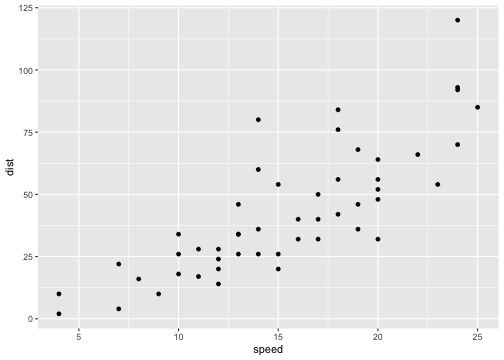<!-- --> ] --- count: false .panel1-enjoy_again-auto[ ```r cars %>% ggplot() + aes(x = speed, y = dist) + geom_point() + * geom_label_row_number(hjust = 1.2) # function in action ``` ] .panel2-enjoy_again-auto[ 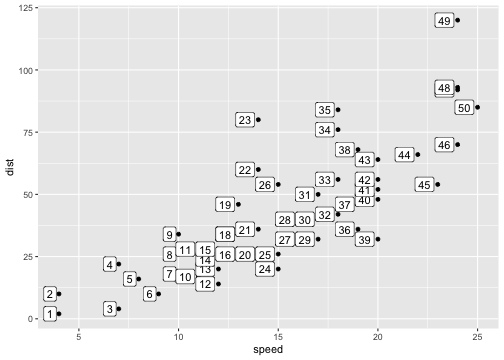<!-- --> ] <style> .panel1-enjoy_again-auto { color: black; width: 38.6060606060606%; hight: 32%; float: left; padding-left: 1%; font-size: 80% } .panel2-enjoy_again-auto { color: black; width: 59.3939393939394%; hight: 32%; float: left; padding-left: 1%; font-size: 80% } .panel3-enjoy_again-auto { color: black; width: NA%; hight: 33%; float: left; padding-left: 1%; font-size: 80% } </style> --- class: inverse, middle, center ### And check out conditionality! -- Note: Because computation is *group-wise*, (i.e. computation is done within discrete group-defining variables) row numbers are computed within group, so rows 1, 2, 3 may be present multiple times. --- count: false .panel1-conditional_compute-auto[ ```r *last_plot() ``` ] .panel2-conditional_compute-auto[ <!-- --> ] --- count: false .panel1-conditional_compute-auto[ ```r last_plot() + * aes(color = dist > 60) ``` ] .panel2-conditional_compute-auto[ 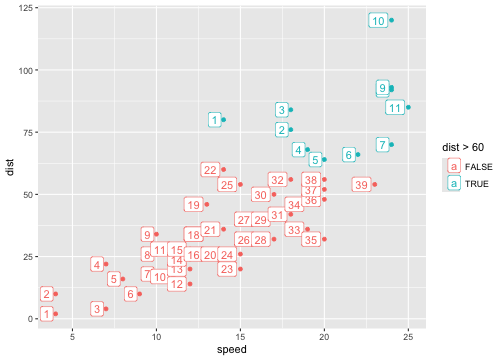<!-- --> ] <style> .panel1-conditional_compute-auto { color: black; width: 38.6060606060606%; hight: 32%; float: left; padding-left: 1%; font-size: 80% } .panel2-conditional_compute-auto { color: black; width: 59.3939393939394%; hight: 32%; float: left; padding-left: 1%; font-size: 80% } .panel3-conditional_compute-auto { color: black; width: NA%; hight: 33%; float: left; padding-left: 1%; font-size: 80% } </style> --- class: inverse, middle, center background-image: url(https://images.unsplash.com/photo-1530751127259-074b0cdc0469?ixlib=rb-1.2.1&ixid=MnwxMjA3fDB8MHxwaG90by1wYWdlfHx8fGVufDB8fHx8&auto=format&fit=crop&w=1413&q=80) background-size: cover --- class: inverse, middle, center ## Now you... -- ### Create the function `geom_text_coordinates()`. -- - geom should label point with its coordinates '(x, y)' - geom should have behavior of geom_text (not geom_label) Hint: `paste0("(", 1, ", ",3., ")")` --- class: inverse, middle, center # Recipe C. -- ## `geom_point_lm_fitted()` --- ## Step 0: use base ggplot2 to get the job done --- count: false .panel1-fitted_1-auto[ ```r *model <- lm(formula = * bill_length_mm ~ bill_depth_mm, * data = penguins) ``` ] .panel2-fitted_1-auto[ ] --- count: false .panel1-fitted_1-auto[ ```r model <- lm(formula = bill_length_mm ~ bill_depth_mm, data = penguins) *penguins_w_fitted <- penguins ``` ] .panel2-fitted_1-auto[ ] --- count: false .panel1-fitted_1-auto[ ```r model <- lm(formula = bill_length_mm ~ bill_depth_mm, data = penguins) penguins_w_fitted <- penguins %>% * mutate(fitted = model$fitted.values) ``` ] .panel2-fitted_1-auto[ ] --- count: false .panel1-fitted_1-auto[ ```r model <- lm(formula = bill_length_mm ~ bill_depth_mm, data = penguins) penguins_w_fitted <- penguins %>% mutate(fitted = model$fitted.values) *penguins ``` ] .panel2-fitted_1-auto[ ``` # A tibble: 333 × 8 species island bill_length_mm bill_depth_mm flipper_length_mm body_mass_g sex year <fct> <fct> <dbl> <dbl> <int> <int> <fct> <int> 1 Adelie Torgersen 39.1 18.7 181 3750 male 2007 2 Adelie Torgersen 39.5 17.4 186 3800 female 2007 3 Adelie Torgersen 40.3 18 195 3250 female 2007 4 Adelie Torgersen 36.7 19.3 193 3450 female 2007 5 Adelie Torgersen 39.3 20.6 190 3650 male 2007 6 Adelie Torgersen 38.9 17.8 181 3625 female 2007 7 Adelie Torgersen 39.2 19.6 195 4675 male 2007 8 Adelie Torgersen 41.1 17.6 182 3200 female 2007 9 Adelie Torgersen 38.6 21.2 191 3800 male 2007 10 Adelie Torgersen 34.6 21.1 198 4400 male 2007 11 Adelie Torgersen 36.6 17.8 185 3700 female 2007 12 Adelie Torgersen 38.7 19 195 3450 female 2007 13 Adelie Torgersen 42.5 20.7 197 4500 male 2007 14 Adelie Torgersen 34.4 18.4 184 3325 female 2007 15 Adelie Torgersen 46 21.5 194 4200 male 2007 16 Adelie Biscoe 37.8 18.3 174 3400 female 2007 17 Adelie Biscoe 37.7 18.7 180 3600 male 2007 18 Adelie Biscoe 35.9 19.2 189 3800 female 2007 19 Adelie Biscoe 38.2 18.1 185 3950 male 2007 20 Adelie Biscoe 38.8 17.2 180 3800 male 2007 21 Adelie Biscoe 35.3 18.9 187 3800 female 2007 22 Adelie Biscoe 40.6 18.6 183 3550 male 2007 23 Adelie Biscoe 40.5 17.9 187 3200 female 2007 24 Adelie Biscoe 37.9 18.6 172 3150 female 2007 25 Adelie Biscoe 40.5 18.9 180 3950 male 2007 26 Adelie Dream 39.5 16.7 178 3250 female 2007 27 Adelie Dream 37.2 18.1 178 3900 male 2007 28 Adelie Dream 39.5 17.8 188 3300 female 2007 29 Adelie Dream 40.9 18.9 184 3900 male 2007 30 Adelie Dream 36.4 17 195 3325 female 2007 31 Adelie Dream 39.2 21.1 196 4150 male 2007 32 Adelie Dream 38.8 20 190 3950 male 2007 33 Adelie Dream 42.2 18.5 180 3550 female 2007 34 Adelie Dream 37.6 19.3 181 3300 female 2007 35 Adelie Dream 39.8 19.1 184 4650 male 2007 36 Adelie Dream 36.5 18 182 3150 female 2007 37 Adelie Dream 40.8 18.4 195 3900 male 2007 38 Adelie Dream 36 18.5 186 3100 female 2007 39 Adelie Dream 44.1 19.7 196 4400 male 2007 40 Adelie Dream 37 16.9 185 3000 female 2007 41 Adelie Dream 39.6 18.8 190 4600 male 2007 42 Adelie Dream 41.1 19 182 3425 male 2007 43 Adelie Dream 36 17.9 190 3450 female 2007 44 Adelie Dream 42.3 21.2 191 4150 male 2007 45 Adelie Biscoe 39.6 17.7 186 3500 female 2008 46 Adelie Biscoe 40.1 18.9 188 4300 male 2008 47 Adelie Biscoe 35 17.9 190 3450 female 2008 48 Adelie Biscoe 42 19.5 200 4050 male 2008 49 Adelie Biscoe 34.5 18.1 187 2900 female 2008 50 Adelie Biscoe 41.4 18.6 191 3700 male 2008 51 Adelie Biscoe 39 17.5 186 3550 female 2008 52 Adelie Biscoe 40.6 18.8 193 3800 male 2008 53 Adelie Biscoe 36.5 16.6 181 2850 female 2008 54 Adelie Biscoe 37.6 19.1 194 3750 male 2008 55 Adelie Biscoe 35.7 16.9 185 3150 female 2008 # ℹ 278 more rows ``` ] --- count: false .panel1-fitted_1-auto[ ```r model <- lm(formula = bill_length_mm ~ bill_depth_mm, data = penguins) penguins_w_fitted <- penguins %>% mutate(fitted = model$fitted.values) penguins %>% * ggplot() ``` ] .panel2-fitted_1-auto[ <!-- --> ] --- count: false .panel1-fitted_1-auto[ ```r model <- lm(formula = bill_length_mm ~ bill_depth_mm, data = penguins) penguins_w_fitted <- penguins %>% mutate(fitted = model$fitted.values) penguins %>% ggplot() + * aes(x = bill_depth_mm, y = bill_length_mm) ``` ] .panel2-fitted_1-auto[ 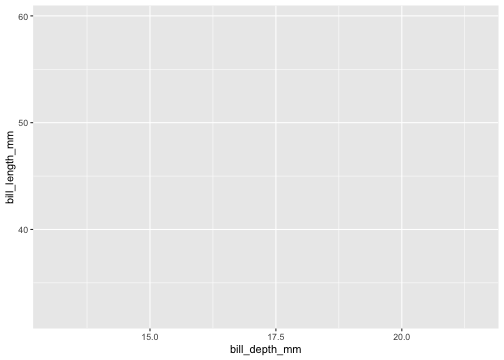<!-- --> ] --- count: false .panel1-fitted_1-auto[ ```r model <- lm(formula = bill_length_mm ~ bill_depth_mm, data = penguins) penguins_w_fitted <- penguins %>% mutate(fitted = model$fitted.values) penguins %>% ggplot() + aes(x = bill_depth_mm, y = bill_length_mm) + * geom_point() ``` ] .panel2-fitted_1-auto[ 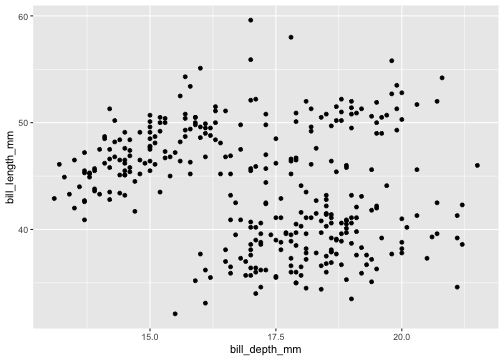<!-- --> ] --- count: false .panel1-fitted_1-auto[ ```r model <- lm(formula = bill_length_mm ~ bill_depth_mm, data = penguins) penguins_w_fitted <- penguins %>% mutate(fitted = model$fitted.values) penguins %>% ggplot() + aes(x = bill_depth_mm, y = bill_length_mm) + geom_point() + * geom_smooth(method = "lm", se = F) ``` ] .panel2-fitted_1-auto[ 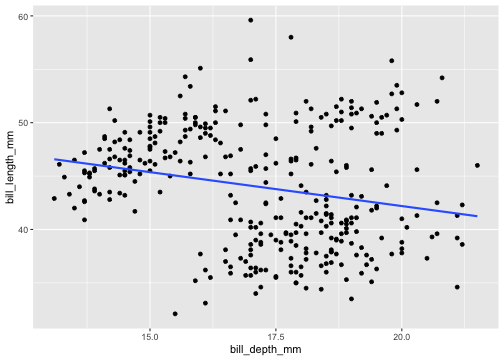<!-- --> ] --- count: false .panel1-fitted_1-auto[ ```r model <- lm(formula = bill_length_mm ~ bill_depth_mm, data = penguins) penguins_w_fitted <- penguins %>% mutate(fitted = model$fitted.values) penguins %>% ggplot() + aes(x = bill_depth_mm, y = bill_length_mm) + geom_point() + geom_smooth(method = "lm", se = F) + * geom_point(data = penguins_w_fitted, * aes(y = fitted), * color = "blue") ``` ] .panel2-fitted_1-auto[ 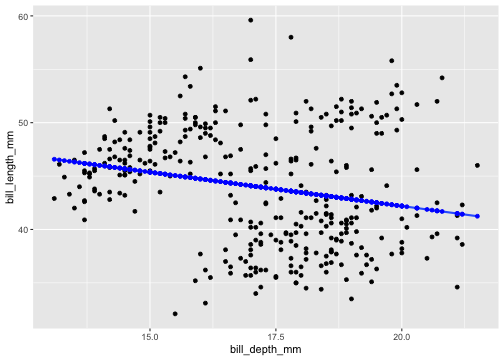<!-- --> ] <style> .panel1-fitted_1-auto { color: black; width: 38.6060606060606%; hight: 32%; float: left; padding-left: 1%; font-size: 80% } .panel2-fitted_1-auto { color: black; width: 59.3939393939394%; hight: 32%; float: left; padding-left: 1%; font-size: 80% } .panel3-fitted_1-auto { color: black; width: NA%; hight: 33%; float: left; padding-left: 1%; font-size: 80% } </style> --- class: inverse, middle, center ## Step 1: define computation --- count: false .panel1-fitted_2-auto[ ```r *compute_group_lm_fitted <- function(data, * scales){ * model<-lm(formula= y ~ x, data = data) * data %>% * mutate(y=model$fitted.values) *} ``` ] .panel2-fitted_2-auto[ ] --- count: false .panel1-fitted_2-auto[ ```r compute_group_lm_fitted <- function(data, scales){ model<-lm(formula= y ~ x, data = data) data %>% mutate(y=model$fitted.values) } # test out the function *penguins ``` ] .panel2-fitted_2-auto[ ``` # A tibble: 333 × 8 species island bill_length_mm bill_depth_mm flipper_length_mm body_mass_g sex year <fct> <fct> <dbl> <dbl> <int> <int> <fct> <int> 1 Adelie Torgersen 39.1 18.7 181 3750 male 2007 2 Adelie Torgersen 39.5 17.4 186 3800 female 2007 3 Adelie Torgersen 40.3 18 195 3250 female 2007 4 Adelie Torgersen 36.7 19.3 193 3450 female 2007 5 Adelie Torgersen 39.3 20.6 190 3650 male 2007 6 Adelie Torgersen 38.9 17.8 181 3625 female 2007 7 Adelie Torgersen 39.2 19.6 195 4675 male 2007 8 Adelie Torgersen 41.1 17.6 182 3200 female 2007 9 Adelie Torgersen 38.6 21.2 191 3800 male 2007 10 Adelie Torgersen 34.6 21.1 198 4400 male 2007 11 Adelie Torgersen 36.6 17.8 185 3700 female 2007 12 Adelie Torgersen 38.7 19 195 3450 female 2007 13 Adelie Torgersen 42.5 20.7 197 4500 male 2007 14 Adelie Torgersen 34.4 18.4 184 3325 female 2007 15 Adelie Torgersen 46 21.5 194 4200 male 2007 16 Adelie Biscoe 37.8 18.3 174 3400 female 2007 17 Adelie Biscoe 37.7 18.7 180 3600 male 2007 18 Adelie Biscoe 35.9 19.2 189 3800 female 2007 19 Adelie Biscoe 38.2 18.1 185 3950 male 2007 20 Adelie Biscoe 38.8 17.2 180 3800 male 2007 21 Adelie Biscoe 35.3 18.9 187 3800 female 2007 22 Adelie Biscoe 40.6 18.6 183 3550 male 2007 23 Adelie Biscoe 40.5 17.9 187 3200 female 2007 24 Adelie Biscoe 37.9 18.6 172 3150 female 2007 25 Adelie Biscoe 40.5 18.9 180 3950 male 2007 26 Adelie Dream 39.5 16.7 178 3250 female 2007 27 Adelie Dream 37.2 18.1 178 3900 male 2007 28 Adelie Dream 39.5 17.8 188 3300 female 2007 29 Adelie Dream 40.9 18.9 184 3900 male 2007 30 Adelie Dream 36.4 17 195 3325 female 2007 31 Adelie Dream 39.2 21.1 196 4150 male 2007 32 Adelie Dream 38.8 20 190 3950 male 2007 33 Adelie Dream 42.2 18.5 180 3550 female 2007 34 Adelie Dream 37.6 19.3 181 3300 female 2007 35 Adelie Dream 39.8 19.1 184 4650 male 2007 36 Adelie Dream 36.5 18 182 3150 female 2007 37 Adelie Dream 40.8 18.4 195 3900 male 2007 38 Adelie Dream 36 18.5 186 3100 female 2007 39 Adelie Dream 44.1 19.7 196 4400 male 2007 40 Adelie Dream 37 16.9 185 3000 female 2007 41 Adelie Dream 39.6 18.8 190 4600 male 2007 42 Adelie Dream 41.1 19 182 3425 male 2007 43 Adelie Dream 36 17.9 190 3450 female 2007 44 Adelie Dream 42.3 21.2 191 4150 male 2007 45 Adelie Biscoe 39.6 17.7 186 3500 female 2008 46 Adelie Biscoe 40.1 18.9 188 4300 male 2008 47 Adelie Biscoe 35 17.9 190 3450 female 2008 48 Adelie Biscoe 42 19.5 200 4050 male 2008 49 Adelie Biscoe 34.5 18.1 187 2900 female 2008 50 Adelie Biscoe 41.4 18.6 191 3700 male 2008 51 Adelie Biscoe 39 17.5 186 3550 female 2008 52 Adelie Biscoe 40.6 18.8 193 3800 male 2008 53 Adelie Biscoe 36.5 16.6 181 2850 female 2008 54 Adelie Biscoe 37.6 19.1 194 3750 male 2008 55 Adelie Biscoe 35.7 16.9 185 3150 female 2008 # ℹ 278 more rows ``` ] --- count: false .panel1-fitted_2-auto[ ```r compute_group_lm_fitted <- function(data, scales){ model<-lm(formula= y ~ x, data = data) data %>% mutate(y=model$fitted.values) } # test out the function penguins %>% # select to explicitly state the x and y inputs * select(x = bill_depth_mm, * y = bill_length_mm) ``` ] .panel2-fitted_2-auto[ ``` # A tibble: 333 × 2 x y <dbl> <dbl> 1 18.7 39.1 2 17.4 39.5 3 18 40.3 4 19.3 36.7 5 20.6 39.3 6 17.8 38.9 7 19.6 39.2 8 17.6 41.1 9 21.2 38.6 10 21.1 34.6 11 17.8 36.6 12 19 38.7 13 20.7 42.5 14 18.4 34.4 15 21.5 46 16 18.3 37.8 17 18.7 37.7 18 19.2 35.9 19 18.1 38.2 20 17.2 38.8 21 18.9 35.3 22 18.6 40.6 23 17.9 40.5 24 18.6 37.9 25 18.9 40.5 26 16.7 39.5 27 18.1 37.2 28 17.8 39.5 29 18.9 40.9 30 17 36.4 31 21.1 39.2 32 20 38.8 33 18.5 42.2 34 19.3 37.6 35 19.1 39.8 36 18 36.5 37 18.4 40.8 38 18.5 36 39 19.7 44.1 40 16.9 37 41 18.8 39.6 42 19 41.1 43 17.9 36 44 21.2 42.3 45 17.7 39.6 46 18.9 40.1 47 17.9 35 48 19.5 42 49 18.1 34.5 50 18.6 41.4 51 17.5 39 52 18.8 40.6 53 16.6 36.5 54 19.1 37.6 55 16.9 35.7 # ℹ 278 more rows ``` ] --- count: false .panel1-fitted_2-auto[ ```r compute_group_lm_fitted <- function(data, scales){ model<-lm(formula= y ~ x, data = data) data %>% mutate(y=model$fitted.values) } # test out the function penguins %>% # select to explicitly state the x and y inputs select(x = bill_depth_mm, y = bill_length_mm) %>% * compute_group_lm_fitted() ``` ] .panel2-fitted_2-auto[ ``` # A tibble: 333 × 2 x y <dbl> <dbl> 1 18.7 43.0 2 17.4 43.8 3 18 43.5 4 19.3 42.6 5 20.6 41.8 6 17.8 43.6 7 19.6 42.4 8 17.6 43.7 9 21.2 41.4 10 21.1 41.5 11 17.8 43.6 12 19 42.8 13 20.7 41.7 14 18.4 43.2 15 21.5 41.2 16 18.3 43.3 17 18.7 43.0 18 19.2 42.7 19 18.1 43.4 20 17.2 44.0 21 18.9 42.9 22 18.6 43.1 23 17.9 43.5 24 18.6 43.1 25 18.9 42.9 26 16.7 44.3 27 18.1 43.4 28 17.8 43.6 29 18.9 42.9 30 17 44.1 31 21.1 41.5 32 20 42.2 33 18.5 43.1 34 19.3 42.6 35 19.1 42.8 36 18 43.5 37 18.4 43.2 38 18.5 43.1 39 19.7 42.4 40 16.9 44.2 41 18.8 43.0 42 19 42.8 43 17.9 43.5 44 21.2 41.4 45 17.7 43.7 46 18.9 42.9 47 17.9 43.5 48 19.5 42.5 49 18.1 43.4 50 18.6 43.1 51 17.5 43.8 52 18.8 43.0 53 16.6 44.4 54 19.1 42.8 55 16.9 44.2 # ℹ 278 more rows ``` ] <style> .panel1-fitted_2-auto { color: black; width: 38.6060606060606%; hight: 32%; float: left; padding-left: 1%; font-size: 80% } .panel2-fitted_2-auto { color: black; width: 59.3939393939394%; hight: 32%; float: left; padding-left: 1%; font-size: 80% } .panel3-fitted_2-auto { color: black; width: NA%; hight: 33%; float: left; padding-left: 1%; font-size: 80% } </style> ## Step 2: define new Stat --- count: false .panel1-fitted_3-1[ ```r StatLmFitted <- ggplot2::ggproto( `_class` = "StatLmFitted", `_inherit` = ggplot2::Stat, required_aes = c("x", "y"), compute_group = compute_group_lm_fitted ) ``` ] .panel2-fitted_3-1[ ] <style> .panel1-fitted_3-1 { color: black; width: 38.6060606060606%; hight: 32%; float: left; padding-left: 1%; font-size: 80% } .panel2-fitted_3-1 { color: black; width: 59.3939393939394%; hight: 32%; float: left; padding-left: 1%; font-size: 80% } .panel3-fitted_3-1 { color: black; width: NA%; hight: 33%; float: left; padding-left: 1%; font-size: 80% } </style> ## Step 3: define user-facing geom\_\* function --- count: false .panel1-fitted_4-1[ ```r geom_point_lm_fitted <- function( mapping = NULL, data = NULL, position = "identity", na.rm = FALSE, show.legend = NA, inherit.aes = TRUE, ...) { ggplot2::layer( stat = StatLmFitted, # proto object from step 2 geom = ggplot2::GeomPoint, # inherit other behavior data = data, mapping = mapping, position = position, show.legend = show.legend, inherit.aes = inherit.aes, params = list(na.rm = na.rm, ...) ) } ``` ] .panel2-fitted_4-1[ ] <style> .panel1-fitted_4-1 { color: black; width: 38.6060606060606%; hight: 32%; float: left; padding-left: 1%; font-size: 80% } .panel2-fitted_4-1 { color: black; width: 59.3939393939394%; hight: 32%; float: left; padding-left: 1%; font-size: 80% } .panel3-fitted_4-1 { color: black; width: NA%; hight: 33%; float: left; padding-left: 1%; font-size: 80% } </style> --- class: inverse, middle, center ## Step 3.b: Enjoy! Use your function --- count: false .panel1-fitted_5-auto[ ```r *penguins ``` ] .panel2-fitted_5-auto[ ``` # A tibble: 333 × 8 species island bill_length_mm bill_depth_mm flipper_length_mm body_mass_g sex year <fct> <fct> <dbl> <dbl> <int> <int> <fct> <int> 1 Adelie Torgersen 39.1 18.7 181 3750 male 2007 2 Adelie Torgersen 39.5 17.4 186 3800 female 2007 3 Adelie Torgersen 40.3 18 195 3250 female 2007 4 Adelie Torgersen 36.7 19.3 193 3450 female 2007 5 Adelie Torgersen 39.3 20.6 190 3650 male 2007 6 Adelie Torgersen 38.9 17.8 181 3625 female 2007 7 Adelie Torgersen 39.2 19.6 195 4675 male 2007 8 Adelie Torgersen 41.1 17.6 182 3200 female 2007 9 Adelie Torgersen 38.6 21.2 191 3800 male 2007 10 Adelie Torgersen 34.6 21.1 198 4400 male 2007 11 Adelie Torgersen 36.6 17.8 185 3700 female 2007 12 Adelie Torgersen 38.7 19 195 3450 female 2007 13 Adelie Torgersen 42.5 20.7 197 4500 male 2007 14 Adelie Torgersen 34.4 18.4 184 3325 female 2007 15 Adelie Torgersen 46 21.5 194 4200 male 2007 16 Adelie Biscoe 37.8 18.3 174 3400 female 2007 17 Adelie Biscoe 37.7 18.7 180 3600 male 2007 18 Adelie Biscoe 35.9 19.2 189 3800 female 2007 19 Adelie Biscoe 38.2 18.1 185 3950 male 2007 20 Adelie Biscoe 38.8 17.2 180 3800 male 2007 21 Adelie Biscoe 35.3 18.9 187 3800 female 2007 22 Adelie Biscoe 40.6 18.6 183 3550 male 2007 23 Adelie Biscoe 40.5 17.9 187 3200 female 2007 24 Adelie Biscoe 37.9 18.6 172 3150 female 2007 25 Adelie Biscoe 40.5 18.9 180 3950 male 2007 26 Adelie Dream 39.5 16.7 178 3250 female 2007 27 Adelie Dream 37.2 18.1 178 3900 male 2007 28 Adelie Dream 39.5 17.8 188 3300 female 2007 29 Adelie Dream 40.9 18.9 184 3900 male 2007 30 Adelie Dream 36.4 17 195 3325 female 2007 31 Adelie Dream 39.2 21.1 196 4150 male 2007 32 Adelie Dream 38.8 20 190 3950 male 2007 33 Adelie Dream 42.2 18.5 180 3550 female 2007 34 Adelie Dream 37.6 19.3 181 3300 female 2007 35 Adelie Dream 39.8 19.1 184 4650 male 2007 36 Adelie Dream 36.5 18 182 3150 female 2007 37 Adelie Dream 40.8 18.4 195 3900 male 2007 38 Adelie Dream 36 18.5 186 3100 female 2007 39 Adelie Dream 44.1 19.7 196 4400 male 2007 40 Adelie Dream 37 16.9 185 3000 female 2007 41 Adelie Dream 39.6 18.8 190 4600 male 2007 42 Adelie Dream 41.1 19 182 3425 male 2007 43 Adelie Dream 36 17.9 190 3450 female 2007 44 Adelie Dream 42.3 21.2 191 4150 male 2007 45 Adelie Biscoe 39.6 17.7 186 3500 female 2008 46 Adelie Biscoe 40.1 18.9 188 4300 male 2008 47 Adelie Biscoe 35 17.9 190 3450 female 2008 48 Adelie Biscoe 42 19.5 200 4050 male 2008 49 Adelie Biscoe 34.5 18.1 187 2900 female 2008 50 Adelie Biscoe 41.4 18.6 191 3700 male 2008 51 Adelie Biscoe 39 17.5 186 3550 female 2008 52 Adelie Biscoe 40.6 18.8 193 3800 male 2008 53 Adelie Biscoe 36.5 16.6 181 2850 female 2008 54 Adelie Biscoe 37.6 19.1 194 3750 male 2008 55 Adelie Biscoe 35.7 16.9 185 3150 female 2008 # ℹ 278 more rows ``` ] --- count: false .panel1-fitted_5-auto[ ```r penguins %>% * ggplot() ``` ] .panel2-fitted_5-auto[ <!-- --> ] --- count: false .panel1-fitted_5-auto[ ```r penguins %>% ggplot() + * aes(x = bill_depth_mm, y = bill_length_mm) ``` ] .panel2-fitted_5-auto[ 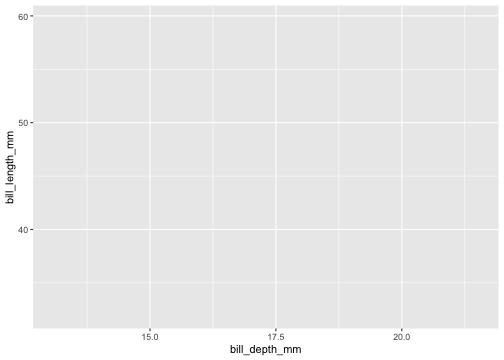<!-- --> ] --- count: false .panel1-fitted_5-auto[ ```r penguins %>% ggplot() + aes(x = bill_depth_mm, y = bill_length_mm) + * geom_point() ``` ] .panel2-fitted_5-auto[ 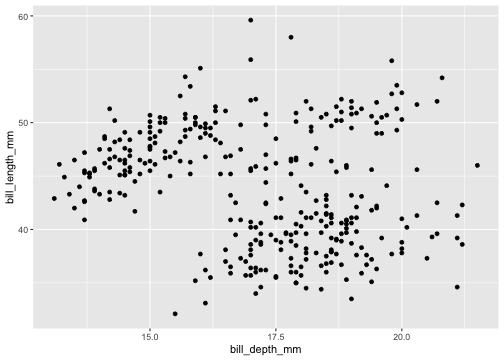<!-- --> ] --- count: false .panel1-fitted_5-auto[ ```r penguins %>% ggplot() + aes(x = bill_depth_mm, y = bill_length_mm) + geom_point() + * geom_smooth(method = "lm", se = F) ``` ] .panel2-fitted_5-auto[ 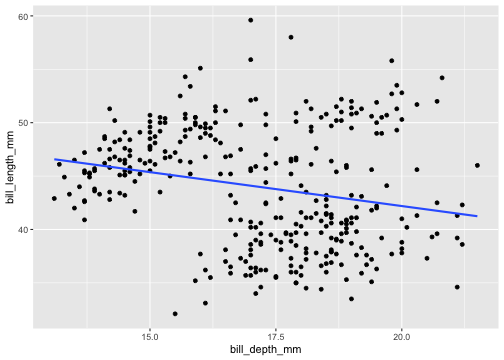<!-- --> ] --- count: false .panel1-fitted_5-auto[ ```r penguins %>% ggplot() + aes(x = bill_depth_mm, y = bill_length_mm) + geom_point() + geom_smooth(method = "lm", se = F)+ * geom_point_lm_fitted(color = "blue") ``` ] .panel2-fitted_5-auto[ 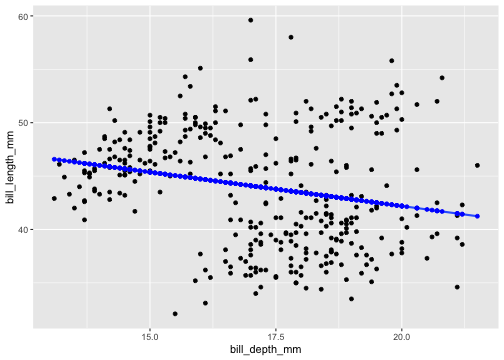<!-- --> ] <style> .panel1-fitted_5-auto { color: black; width: 38.6060606060606%; hight: 32%; float: left; padding-left: 1%; font-size: 80% } .panel2-fitted_5-auto { color: black; width: 59.3939393939394%; hight: 32%; float: left; padding-left: 1%; font-size: 80% } .panel3-fitted_5-auto { color: black; width: NA%; hight: 33%; float: left; padding-left: 1%; font-size: 80% } </style> --- class: inverse, middle, center ### And check out conditionality --- count: false .panel1-fitted_6-auto[ ```r *penguins ``` ] .panel2-fitted_6-auto[ ``` # A tibble: 333 × 8 species island bill_length_mm bill_depth_mm flipper_length_mm body_mass_g sex year <fct> <fct> <dbl> <dbl> <int> <int> <fct> <int> 1 Adelie Torgersen 39.1 18.7 181 3750 male 2007 2 Adelie Torgersen 39.5 17.4 186 3800 female 2007 3 Adelie Torgersen 40.3 18 195 3250 female 2007 4 Adelie Torgersen 36.7 19.3 193 3450 female 2007 5 Adelie Torgersen 39.3 20.6 190 3650 male 2007 6 Adelie Torgersen 38.9 17.8 181 3625 female 2007 7 Adelie Torgersen 39.2 19.6 195 4675 male 2007 8 Adelie Torgersen 41.1 17.6 182 3200 female 2007 9 Adelie Torgersen 38.6 21.2 191 3800 male 2007 10 Adelie Torgersen 34.6 21.1 198 4400 male 2007 11 Adelie Torgersen 36.6 17.8 185 3700 female 2007 12 Adelie Torgersen 38.7 19 195 3450 female 2007 13 Adelie Torgersen 42.5 20.7 197 4500 male 2007 14 Adelie Torgersen 34.4 18.4 184 3325 female 2007 15 Adelie Torgersen 46 21.5 194 4200 male 2007 16 Adelie Biscoe 37.8 18.3 174 3400 female 2007 17 Adelie Biscoe 37.7 18.7 180 3600 male 2007 18 Adelie Biscoe 35.9 19.2 189 3800 female 2007 19 Adelie Biscoe 38.2 18.1 185 3950 male 2007 20 Adelie Biscoe 38.8 17.2 180 3800 male 2007 21 Adelie Biscoe 35.3 18.9 187 3800 female 2007 22 Adelie Biscoe 40.6 18.6 183 3550 male 2007 23 Adelie Biscoe 40.5 17.9 187 3200 female 2007 24 Adelie Biscoe 37.9 18.6 172 3150 female 2007 25 Adelie Biscoe 40.5 18.9 180 3950 male 2007 26 Adelie Dream 39.5 16.7 178 3250 female 2007 27 Adelie Dream 37.2 18.1 178 3900 male 2007 28 Adelie Dream 39.5 17.8 188 3300 female 2007 29 Adelie Dream 40.9 18.9 184 3900 male 2007 30 Adelie Dream 36.4 17 195 3325 female 2007 31 Adelie Dream 39.2 21.1 196 4150 male 2007 32 Adelie Dream 38.8 20 190 3950 male 2007 33 Adelie Dream 42.2 18.5 180 3550 female 2007 34 Adelie Dream 37.6 19.3 181 3300 female 2007 35 Adelie Dream 39.8 19.1 184 4650 male 2007 36 Adelie Dream 36.5 18 182 3150 female 2007 37 Adelie Dream 40.8 18.4 195 3900 male 2007 38 Adelie Dream 36 18.5 186 3100 female 2007 39 Adelie Dream 44.1 19.7 196 4400 male 2007 40 Adelie Dream 37 16.9 185 3000 female 2007 41 Adelie Dream 39.6 18.8 190 4600 male 2007 42 Adelie Dream 41.1 19 182 3425 male 2007 43 Adelie Dream 36 17.9 190 3450 female 2007 44 Adelie Dream 42.3 21.2 191 4150 male 2007 45 Adelie Biscoe 39.6 17.7 186 3500 female 2008 46 Adelie Biscoe 40.1 18.9 188 4300 male 2008 47 Adelie Biscoe 35 17.9 190 3450 female 2008 48 Adelie Biscoe 42 19.5 200 4050 male 2008 49 Adelie Biscoe 34.5 18.1 187 2900 female 2008 50 Adelie Biscoe 41.4 18.6 191 3700 male 2008 51 Adelie Biscoe 39 17.5 186 3550 female 2008 52 Adelie Biscoe 40.6 18.8 193 3800 male 2008 53 Adelie Biscoe 36.5 16.6 181 2850 female 2008 54 Adelie Biscoe 37.6 19.1 194 3750 male 2008 55 Adelie Biscoe 35.7 16.9 185 3150 female 2008 # ℹ 278 more rows ``` ] --- count: false .panel1-fitted_6-auto[ ```r penguins %>% * ggplot() ``` ] .panel2-fitted_6-auto[ <!-- --> ] --- count: false .panel1-fitted_6-auto[ ```r penguins %>% ggplot() + * aes(x = bill_depth_mm, * y = bill_length_mm) ``` ] .panel2-fitted_6-auto[ 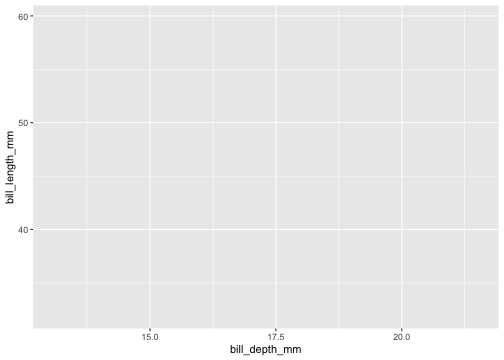<!-- --> ] --- count: false .panel1-fitted_6-auto[ ```r penguins %>% ggplot() + aes(x = bill_depth_mm, y = bill_length_mm) + * geom_point() ``` ] .panel2-fitted_6-auto[ 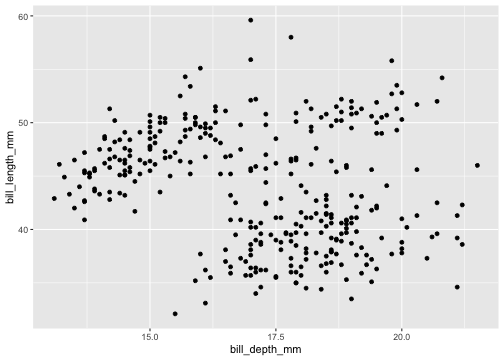<!-- --> ] --- count: false .panel1-fitted_6-auto[ ```r penguins %>% ggplot() + aes(x = bill_depth_mm, y = bill_length_mm) + geom_point() + * geom_smooth(method="lm", se= F) ``` ] .panel2-fitted_6-auto[ 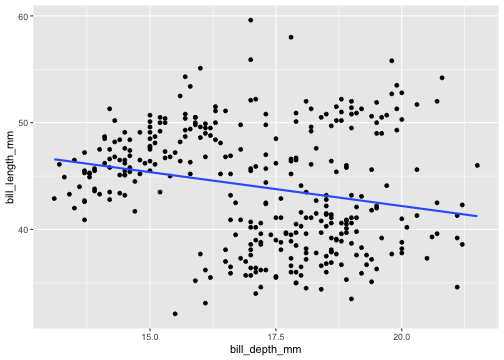<!-- --> ] --- count: false .panel1-fitted_6-auto[ ```r penguins %>% ggplot() + aes(x = bill_depth_mm, y = bill_length_mm) + geom_point() + geom_smooth(method="lm", se= F) + * geom_point_lm_fitted() ``` ] .panel2-fitted_6-auto[ 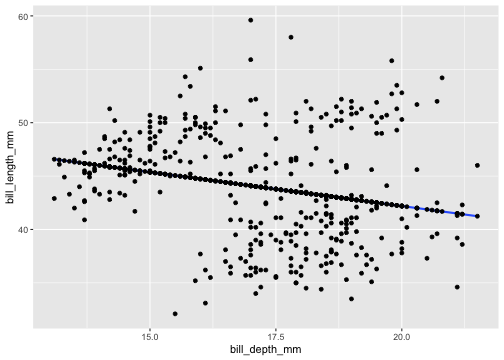<!-- --> ] --- count: false .panel1-fitted_6-auto[ ```r penguins %>% ggplot() + aes(x = bill_depth_mm, y = bill_length_mm) + geom_point() + geom_smooth(method="lm", se= F) + geom_point_lm_fitted() + * facet_wrap(facets = vars(species)) ``` ] .panel2-fitted_6-auto[ 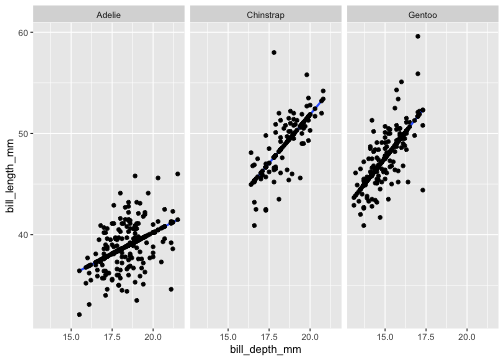<!-- --> ] <style> .panel1-fitted_6-auto { color: black; width: 38.6060606060606%; hight: 32%; float: left; padding-left: 1%; font-size: 80% } .panel2-fitted_6-auto { color: black; width: 59.3939393939394%; hight: 32%; float: left; padding-left: 1%; font-size: 80% } .panel3-fitted_6-auto { color: black; width: NA%; hight: 33%; float: left; padding-left: 1%; font-size: 80% } </style> --- class: inverse, middle, center background-image: url(https://images.unsplash.com/photo-1499636136210-6f4ee915583e?ixlib=rb-1.2.1&ixid=MnwxMjA3fDB8MHxwaG90by1wYWdlfHx8fGVufDB8fHx8&auto=format&fit=crop&w=464&q=80) background-size: cover --- class: inverse, middle, center ## Now you... Create the function `geom_segment_lm_residuals()`. -- ### Hint: read about what aesthetics are required for segments. We'll give you Step 0 this time... -- ## Step 0: use base ggplot2 to get the job done --- count: false .panel1-residuals-auto[ ```r *model <- lm(formula = * bill_length_mm ~ bill_depth_mm, * data = penguins) ``` ] .panel2-residuals-auto[ ] --- count: false .panel1-residuals-auto[ ```r model <- lm(formula = bill_length_mm ~ bill_depth_mm, data = penguins) *penguins_w_fitted <- penguins ``` ] .panel2-residuals-auto[ ] --- count: false .panel1-residuals-auto[ ```r model <- lm(formula = bill_length_mm ~ bill_depth_mm, data = penguins) penguins_w_fitted <- penguins %>% * mutate(fitted = model$fitted.values) ``` ] .panel2-residuals-auto[ ] --- count: false .panel1-residuals-auto[ ```r model <- lm(formula = bill_length_mm ~ bill_depth_mm, data = penguins) penguins_w_fitted <- penguins %>% mutate(fitted = model$fitted.values) *penguins ``` ] .panel2-residuals-auto[ ``` # A tibble: 333 × 8 species island bill_length_mm bill_depth_mm flipper_length_mm body_mass_g sex year <fct> <fct> <dbl> <dbl> <int> <int> <fct> <int> 1 Adelie Torgersen 39.1 18.7 181 3750 male 2007 2 Adelie Torgersen 39.5 17.4 186 3800 female 2007 3 Adelie Torgersen 40.3 18 195 3250 female 2007 4 Adelie Torgersen 36.7 19.3 193 3450 female 2007 5 Adelie Torgersen 39.3 20.6 190 3650 male 2007 6 Adelie Torgersen 38.9 17.8 181 3625 female 2007 7 Adelie Torgersen 39.2 19.6 195 4675 male 2007 8 Adelie Torgersen 41.1 17.6 182 3200 female 2007 9 Adelie Torgersen 38.6 21.2 191 3800 male 2007 10 Adelie Torgersen 34.6 21.1 198 4400 male 2007 11 Adelie Torgersen 36.6 17.8 185 3700 female 2007 12 Adelie Torgersen 38.7 19 195 3450 female 2007 13 Adelie Torgersen 42.5 20.7 197 4500 male 2007 14 Adelie Torgersen 34.4 18.4 184 3325 female 2007 15 Adelie Torgersen 46 21.5 194 4200 male 2007 16 Adelie Biscoe 37.8 18.3 174 3400 female 2007 17 Adelie Biscoe 37.7 18.7 180 3600 male 2007 18 Adelie Biscoe 35.9 19.2 189 3800 female 2007 19 Adelie Biscoe 38.2 18.1 185 3950 male 2007 20 Adelie Biscoe 38.8 17.2 180 3800 male 2007 21 Adelie Biscoe 35.3 18.9 187 3800 female 2007 22 Adelie Biscoe 40.6 18.6 183 3550 male 2007 23 Adelie Biscoe 40.5 17.9 187 3200 female 2007 24 Adelie Biscoe 37.9 18.6 172 3150 female 2007 25 Adelie Biscoe 40.5 18.9 180 3950 male 2007 26 Adelie Dream 39.5 16.7 178 3250 female 2007 27 Adelie Dream 37.2 18.1 178 3900 male 2007 28 Adelie Dream 39.5 17.8 188 3300 female 2007 29 Adelie Dream 40.9 18.9 184 3900 male 2007 30 Adelie Dream 36.4 17 195 3325 female 2007 31 Adelie Dream 39.2 21.1 196 4150 male 2007 32 Adelie Dream 38.8 20 190 3950 male 2007 33 Adelie Dream 42.2 18.5 180 3550 female 2007 34 Adelie Dream 37.6 19.3 181 3300 female 2007 35 Adelie Dream 39.8 19.1 184 4650 male 2007 36 Adelie Dream 36.5 18 182 3150 female 2007 37 Adelie Dream 40.8 18.4 195 3900 male 2007 38 Adelie Dream 36 18.5 186 3100 female 2007 39 Adelie Dream 44.1 19.7 196 4400 male 2007 40 Adelie Dream 37 16.9 185 3000 female 2007 41 Adelie Dream 39.6 18.8 190 4600 male 2007 42 Adelie Dream 41.1 19 182 3425 male 2007 43 Adelie Dream 36 17.9 190 3450 female 2007 44 Adelie Dream 42.3 21.2 191 4150 male 2007 45 Adelie Biscoe 39.6 17.7 186 3500 female 2008 46 Adelie Biscoe 40.1 18.9 188 4300 male 2008 47 Adelie Biscoe 35 17.9 190 3450 female 2008 48 Adelie Biscoe 42 19.5 200 4050 male 2008 49 Adelie Biscoe 34.5 18.1 187 2900 female 2008 50 Adelie Biscoe 41.4 18.6 191 3700 male 2008 51 Adelie Biscoe 39 17.5 186 3550 female 2008 52 Adelie Biscoe 40.6 18.8 193 3800 male 2008 53 Adelie Biscoe 36.5 16.6 181 2850 female 2008 54 Adelie Biscoe 37.6 19.1 194 3750 male 2008 55 Adelie Biscoe 35.7 16.9 185 3150 female 2008 # ℹ 278 more rows ``` ] --- count: false .panel1-residuals-auto[ ```r model <- lm(formula = bill_length_mm ~ bill_depth_mm, data = penguins) penguins_w_fitted <- penguins %>% mutate(fitted = model$fitted.values) penguins %>% * ggplot() ``` ] .panel2-residuals-auto[ <!-- --> ] --- count: false .panel1-residuals-auto[ ```r model <- lm(formula = bill_length_mm ~ bill_depth_mm, data = penguins) penguins_w_fitted <- penguins %>% mutate(fitted = model$fitted.values) penguins %>% ggplot() + * aes(x = bill_depth_mm, y = bill_length_mm) ``` ] .panel2-residuals-auto[ 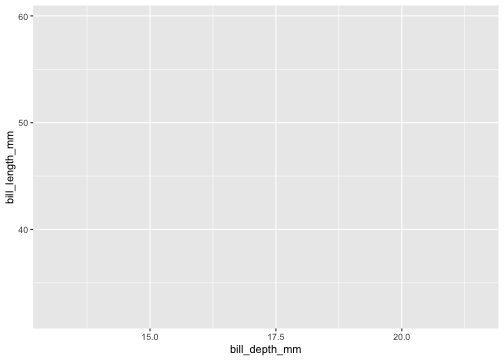<!-- --> ] --- count: false .panel1-residuals-auto[ ```r model <- lm(formula = bill_length_mm ~ bill_depth_mm, data = penguins) penguins_w_fitted <- penguins %>% mutate(fitted = model$fitted.values) penguins %>% ggplot() + aes(x = bill_depth_mm, y = bill_length_mm) + * geom_point() ``` ] .panel2-residuals-auto[ 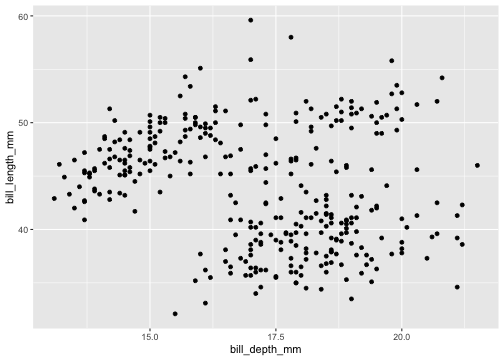<!-- --> ] --- count: false .panel1-residuals-auto[ ```r model <- lm(formula = bill_length_mm ~ bill_depth_mm, data = penguins) penguins_w_fitted <- penguins %>% mutate(fitted = model$fitted.values) penguins %>% ggplot() + aes(x = bill_depth_mm, y = bill_length_mm) + geom_point() + * geom_smooth(method = "lm", se = F) ``` ] .panel2-residuals-auto[ 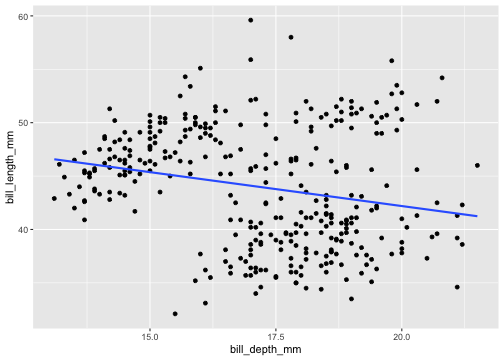<!-- --> ] --- count: false .panel1-residuals-auto[ ```r model <- lm(formula = bill_length_mm ~ bill_depth_mm, data = penguins) penguins_w_fitted <- penguins %>% mutate(fitted = model$fitted.values) penguins %>% ggplot() + aes(x = bill_depth_mm, y = bill_length_mm) + geom_point() + geom_smooth(method = "lm", se = F) + * geom_segment(data = penguins_w_fitted, * aes(yend = fitted, xend = bill_depth_mm), * color = "blue") ``` ] .panel2-residuals-auto[ 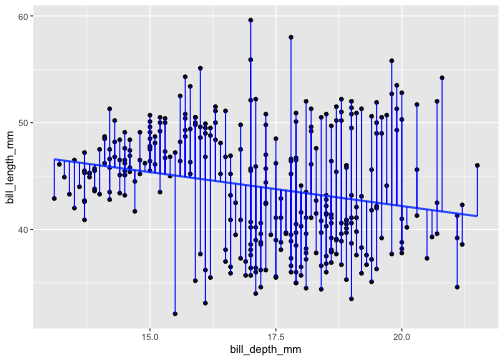<!-- --> ] <style> .panel1-residuals-auto { color: black; width: 38.6060606060606%; hight: 32%; float: left; padding-left: 1%; font-size: 80% } .panel2-residuals-auto { color: black; width: 59.3939393939394%; hight: 32%; float: left; padding-left: 1%; font-size: 80% } .panel3-residuals-auto { color: black; width: NA%; hight: 33%; float: left; padding-left: 1%; font-size: 80% } </style> --- #### Photo Credits: Thalia Ruiz, Jennifer Pallian, Lisa Hanly, John Dancy, Piper Bchamp #### More comprehensive extension resources: - [ggplot2-extension-cookbook: an example-rich Stat-focused resource](https://evamaerey.github.io/ggplot2-extension-cookbook/) Gina Reynolds - [Extending your ability to extend ggplot2: StatCircle demo and high level overview](https://www.youtube.com/watch?v=uj7A3i2fi54) Thomas Lin Pederson - [Extending ggplot2 package Vignette: walkthough many extension mechanisms](https://cran.r-project.org/web/packages/ggplot2/vignettes/extending-ggplot2.html) - [Extending ggplot2 chapter](https://ggplot2-book.org/extensions.html)